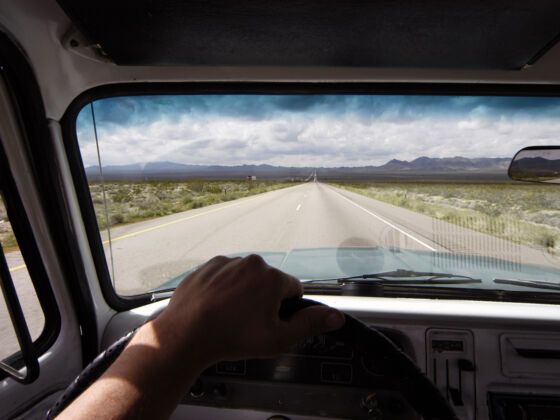It was about five years ago that I first hatched the idea for my upcoming book, The Footloose American: Following the Hunter S. Thompson Trail Across South America. I was a grad student at the time and initially pitched the Thompson Trail to the US Fulbright Program as a sort of vaguely scholarly post-graduate research project. As my proposal explained, even devoted fans of Thompson — the self-proclaimed “gonzo journalist,” author of Hell’s Angels and Fear and Loathing in Las Vegas, among others — are often surprised to learn about his stint as a foreign correspondent, reporting on Cold War politics from various locations across South America in 1962 and 1963.

Notes on the 'Stragglelogue' as a Travel Book Genre, and How I Followed Hunter S. Thompson
“My intent,” read my doomed application, “is to retrace Thompson’s route across the continent, revisiting the sites that formed the basis of his groundbreaking writing in the National Observer in the early 1960s. The result will be a research-based work of longform nonfiction, a travel narrative leading the reader along Thompson’s course, comparing the South America of his stories with the reality of the continent today.”
Not long after applying, I went out for a beer and ran into my landlord, an accomplished fiction writer to whom I mentioned my proposed literary pilgrimage. Roundly unimpressed, he swigged from what must have been his fifth Scotch ale before turning to me with a shrug.
“Why would you want to follow in somebody else’s footsteps?” he asked, wiping his mustache with the back of his hand. “Why recreate someone else’s journey? Wouldn’t you rather blaze your own trail and write about that?”
When the Fulbright people eventually turned me down, I said the hell with them anyway and hit the Thompson Trail on my own, ultimately spending six months retracing Thompson’s South American circuit. I slept on a gurney for a week in a rural Paraguayan clinic, got swept up by a populist street mob in Lima, spent Easter morning arguing politics in a transvestite brothel, and was marooned in Colombia when monsoon rains sunk the boat I was traveling on. I won’t say it was a gonzo trip, exactly — I spent far too much time conducting interviews and nerding out in museums for that — but it was lively and enlightening and profoundly fulfilling.
And yet, five years and 8,000 miles later, my drunken landlord’s questions still ring in my head. Did the guy have a point? Is there a sense in which following the trails of our heroes is, in fact, a bit of a travel crutch? A kind of high-concept cop-out that keeps us from blazing trails of our own?
As a reader, I am a devoted fan of the “following in the footsteps” narrative, a bona fide literary sub=genre that I’ve taken to calling the stragglelogue. Among my all-time favorite books are Scott Huler’s No-Man’s Lands (straggling behind Odysseus), Patrick Symmes’ Chasing Che (straggling behind Che Guevara), and Tim Mackintosh-Smith’s Travels with a Tangerine (straggling behind Moroccan explorer Ibn Battutah). It’s a form with a long pedigree, stretching all the way back to Herodotus’ Histories — arguably the world’s oldest travel book, published around 440 BC — which was, among other things, a stragglelogue retracing the routes of the early Greek colonists across Asia Minor. The British travel writer Justin Marozzi even took things meta a few years back, following in the footsteps of the ancient Greek historian himself, making his book The Way of Herodotus perhaps the first-ever stragglelogue of a stragglelogue.
Driven as it is by historical inquiry (some might say gimmick) rather than conventional plot, the stragglelogue is an oddball genre. In an article in the current issue of The Writer’s Chronicle, the novelist Sabina Murray writes, “Plot is unnecessary to move a book around when you’ve given the narrative an actual pair of legs, pair of eyes, and an articulate, thoughtful voice.” She’s talking about the late German author W.G. Sebald, but she might be describing the best of the stragglelogue sub-genre.
And where does this leave us workaday travelers? Is a backpacking tour of George Orwell’s Burma any less gnarly for having Orwell as a guide? My own travels along the Hunter S. Thompson Trail were certainly derivative, but does that make them any less meaningful, any less authentic?
My take on all this is rooted in an acceptance of the fact that we are all stragglers now, all of us following in the footsteps of countless, anonymous others. There is no more terra incognita, if there ever was any to start, one man’s incognita being another woman’s backyard. There are no trails left untrod. In only the most isolated of circumstances will a human being on this planet ever again stumble into a corner of the world that hasn’t been thoroughly explored, photographed, mapped, and otherwise documented. And while this may seem demoralizing at first, the silver lining is a gradual unveiling of whole new dimensions of travel, unknown and unknowable to yesteryear’s swashbucklers. History is a space through which I travel now just as easily as longitude, latitude, and altitude. Thanks to the steady accumulation and diffusion of human knowledge, the enticing blankness of terra incognita has been replaced with bottomless strata of story and meaning and causality that, know it or not, I am forever drifting through, like a scuba diver among the eddies.
For me, then, the landlord had it all wrong. The appeal of trailblazing is limited. My aim instead is to keep on following — to follow better, follow deeper, until I find myself traveling alongside not only Thompson, but the Inca priestess who came before him, the conquistador who struck her down, and the Wari laborer who laid the stones beneath them, now matted over with layers of unseen footprints. Editor’s note: For pre-order information about The Footloose American: Following the Hunter S. Thompson Trail Across South America, follow @BrianMT on Twitter.